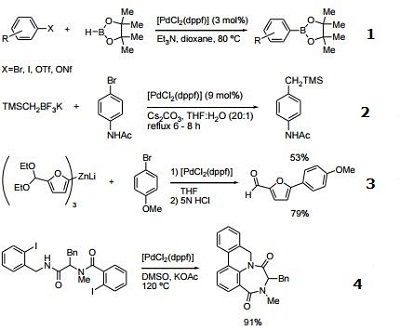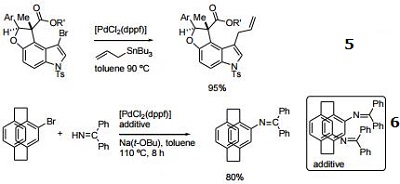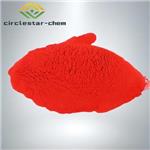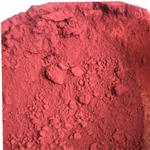- Catalyst for the borylation of aryl halides.
- β-Alkyl Suzuki-Miyaura cross-coupling reactions with potassium alkyltrifluoroborates.
- Catalyst for modified Negishi coupling.
- Synthesis of polyheterocycles by a Pd-catalyzed intramolecular N-arylation/C-H bond activation/aryl-aryl bond-forming domino process.
- Catalyst for Stille allylation.
- Catalyst for the amination of aryl bromides.


1,1'-Bis(diphenylphosphino)ferrocene-palladium(II)dichloride dichloromethane complex is used in the preparation of imidazoles, benzimidazoles, and tetrahydropyrimidines,it is also used as a catalyst for Suzuki and Stile couplings.
1,1'-Bis(diphenylphosphino)ferrocene-palladium(II)dichloride dichloromethane complex is an organometallic compound that can be used as a noble metal catalyst for carbonylation reactions, cross-coupling reactions, Suzuki reaction.
core: palladium
reaction type: Buchwald-Hartwig Cross Coupling Reaction
reaction type: Cross Couplings
reaction type: Heck Reaction
reaction type: Hiyama Coupling
reaction type: Negishi Coupling
reaction type: Sonogashira Coupling
reaction type: Stille Coupling
reaction type: Suzuki-Miyaura Coupling
reagent type: catalyst
1. Dissolve 2.00 grams of sodium palladium chloride in 30mL of anhydrous ethanol to obtain the ethanol solution of sodium palladium chloride;
2. Dissolve 4.15 grams of 1,1 '-bis (diphenylphosphine) ferrocene in 41mL dichloromethane to obtain 1,1' -bis (diphenylphosphine) ferrocene dichloromethane solution;
3. Under stirring conditions, add the ethanol solution of sodium palladite chloride in step 1 to dichloromethane solution of 1, 1 '-bis (diphenylphosphine) ferrocene in step 2. Stir and react for 1h at 25℃. 1,1'-Bis(diphenylphosphino)ferrocene-palladium(II)dichloride dichloromethane complex crystal, yield 90.46%.
In this method, the target product 1,1'-Bis(diphenylphosphino)ferrocene-palladium(II)dichloride dichloromethane complex was synthesized directly with dichloromethane as the solvent in one step, eliminating the synthesis process of precursor PDCl2 (DPPF). The reaction process is simple, the synthesis cycle is short, easy to operate, and the purity of the synthesized product is 99.4%.





